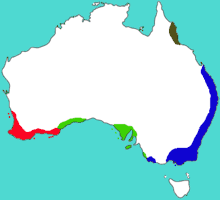Bush rat
| Bush rat | |
|---|---|
| Scientific classification | |
| Kingdom: | Animalia |
| Phylum: | Chordata |
| Class: | Mammalia |
| Order: | Rodentia |
| Family: | Muridae |
| Genus: | Rattus |
| Species: | R. fuscipes |
| Binomial name | |
| Rattus fuscipes (Waterhouse, 1839) | |
 | |
| Distribution on subspecies-level: red=R. f. fuscipes; green=R. f. greyi, blue=R. f. assimilis, brown=R. f. coracius | |
The bush rat (Rattus fuscipes) is a small Australian nocturnal animal. It is an omnivore and one of the most common indigenous species of rats on the continent, found in many heathland areas of Victoria and NSW.
Description
While there are not many characteristics that distinguish the bush rat from other Rattus species, it is characterized by having a small tympanic bullae and a straight incisive foramina. Adult bush rats are smaller than the Australian swamp rat (Rattus lutreolus) and in addition, the bush rat's foot pads are a pink colour, whereas the swamp rat's foot pads are dark brown. The feet are pentadactyl with all digits clawed. The bush rat exhibits sexual dimorphism: the males are larger than the females in the species.[2]
Distribution and habitat
The bush rat is found primarily in the coastal regions of southwestern Australia. While it is mainly found in the lowlands, the bush rat can also be found in parts of the Australian Alps and on some offshore islands, including Kangaroo Island. The bush rat is terrestrial and prefers areas with dense undergrowth. It constructs a burrow that leads down into the nest chamber and is lined with grass and other vegetation.[1]
Threats
Some of the biggest threats to the bush rat include red foxes and feral cats, both introduced species. Evidence suggests that the incidence of fire can increase predation of bush rats due to the removal of undergrowth in which they are usually able to hide.[3]
Diet
The bush rat doesn't show much overlap in diet with other local rodent species. In the summer it consumes primarily fruit, arthropods, and seeds, but in the winter its main source of food is from a particular cyperaceous species. When found in the forest it consumes primarily fungi and various fibrous plant material.[4] Bush rats have been observed feeding on nectar without damaging the blossoms, thus likely aiding in pollination.[5]
Behaviour
The bush rat is strictly nocturnal and is active year-round. Adults seem to be nomadic, but will rarely leave the forest floor. The bush rat was once considered to be solely a herbivore but recently it has been discovered that it is an omnivore. It is also the host to more parasites than any other Australian rodent. They exhibit stereotypically normal behaviour when approaching an intruder; boxing, threat-posture, clash, approach. The bush rat is prey to some local predators, including dingoes, foxes, birds of prey and reptiles.
Bush rats tend to avoid areas impacted by humans, and populations tend to decline when anthropogenic influences in a region increase.[6]
Breeding behavior
The bush rat begins breeding around November and has litter sizes ranging usually between 4-5. The majority of individuals do not live to a second breeding cycle due to their short life span. The gestation period of the bush rat varies between 22 and 24 days. The "nursery" of the bush rat is its burrow. The nursing period lasts for about the first 20–25 days of life.[7]
External links
Notes and references
- 1 2 Menkhorst, P.; Lunney, D.; Ellis, M.; Burnett, S. & Friend, T. (2008). "Rattus fuscipes". IUCN Red List of Threatened Species. Version 2015.3. International Union for Conservation of Nature. Retrieved 17 September 2015.
- ↑ "Bush Rat - Rattus fuscipes assimilis". NSW Wildlife Information, Rescue and Education Service.
- ↑ Hradsky, Bronwyn; Craig, Mildwaters; Ritchie, Euan G.; Christie, Fiona; Di Stefano, Julian (8 March 2017). "Responses of invasive predators and native prey to a prescribed forest fire". J Mammal 2017 gyx010. doi:10.1093/jmammal/gyx010.
- ↑ Cheal, DC (1987). "The Diets and Dietary Preferences of Rattus-fuscipes and Rattus-lutreolus at Walkerville in Victoria". Australian Wildlife Research. 14: 35–44. doi:10.1071/WR9870035.
- ↑ Saul, A. (2013). Aliens replacing natives: are black rats effective substitutes for extinct native mammalian pollinators? (PDF) (PhD thesis). University of Sydney. Retrieved 21 October 2015.
- ↑ Lindenmayer, D. B.; Cunningham, R. B.; Peakall, R. (2005). "The recovery of populations of bush rat Rattus fuscipes in forest fragments following major population reduction". Journal of Applied Ecology. 42 (4): 649–658. doi:10.1111/j.1365-2664.2005.01054.x.
- ↑ Wood, DH (1971). "The ecology of Rattus fuscipes and Melomys cervinipes (Rodentia : Muridae) in a south-east Queensland rain forest". Australian Journal of Zoology. 19: 371–392. doi:10.1071/ZO9710371.
